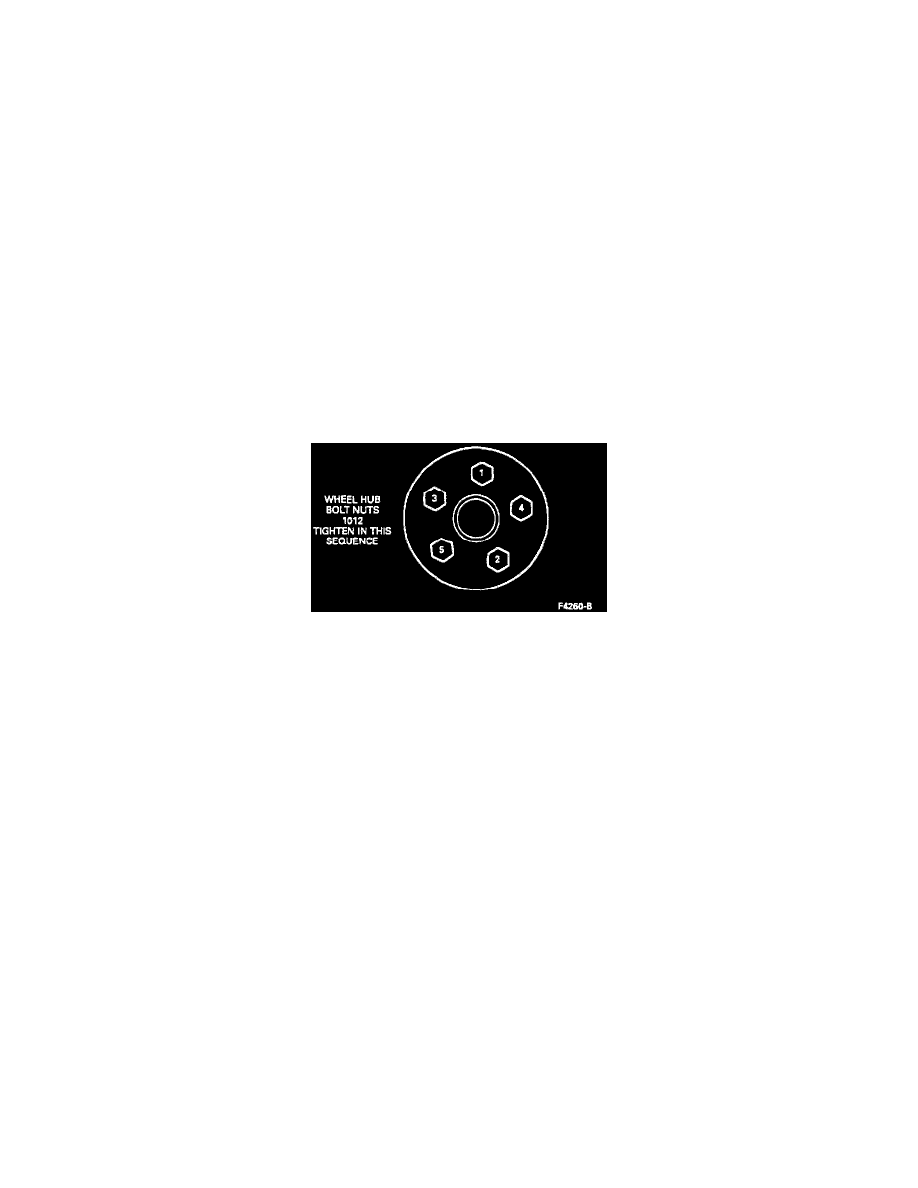Ranger 2WD V6-245 4.0L VIN X SFI (1997)

Wheels: Component Tests and General Diagnostics
Distorted Wheel Inspection
Inspect for Wheel Damage
Replace wheels if they are bent, cracked, leaking air or heavily rusted or if the wheel hub bolt nuts often become loose. Do not use bent wheels that
have been straightened and do not use inner tubes in leaking wheels. Do not replace wheels with used wheels. Wheels that have been straightened, are
leaking air, or are used may have structural damage and could fail without warning. Check for damage that could affect the runout of the wheels.
Wobble or shimmy will eventually damage the wheel bearings.
Install Wheel
1. Position the wheel on the hub and rotor or the axle flange and drum assembly.
WARNING: WHENEVER A WHEEL IS INSTALLED, ALWAYS REMOVE ANY CORROSION, DIRT OR FOREIGN MATERIAL
THAT MAY BE PRESENT ON THE MOUNTING SURFACES OF THE HUB, DRUM OR ROTOR THAT CONTACTS THE WHEEL.
INSTALLING WHEELS WITHOUT PROPER METAL-TO-METAL CONTACT AT THE WHEEL MOUNTING SURFACES CAN
CAUSE THE WHEEL HUB BOLT NUTS TO LOOSEN AND COULD ALLOW THE WHEEL TO COME OFF WHILE THE
VEHICLE IS IN MOTION CAUSING LOSS OF CONTROL.
2. Install the wheel hub bolt nuts making sure the cone end of the nuts faces inward.
3. With the wheel hub bolt nuts loosely installed, turn the wheel until one wheel hub bolt nut is at the top of the bolt circle. Tighten the wheel hub
bolt nut until snug.
4. In a criss-cross pattern, tighten the remaining wheel hub bot nuts until snug to minimize runout.
5. Remove the jackstand and lower the vehicle.
6. Evenly tighten the wheel hub bolt nuts in the torque sequence shown below to 135 N-m (100 lb-ft).
WARNING: IMPROPERLY TIGHTENED WHEEL HUB BOLT NUTS COULD ALLOW THE WHEEL TO COME OFF WHILE
THE VEHICLE IS IN MOTION, CAUSING LOSS OF CONTROL. DO NOT USE A LUBRICANT ON THE WHEEL HUB BOLT
NUTS TO FACILITATE FUTURE REMOVAL OF THE WHEEL ASSEMBLY.
7. Retighten the wheel hub bolt nuts to 135 Nm (100 lb ft) at 800 km (500 miles) after any wheel change or any other time the wheel hub bolt nuts
have been loosened. This is required to permit the wheel clamping system to seat properly so that the wheel hub bolt nuts will hold a uniform
clamp load and remain fully tightened.
Leaks
Pinhole leaks in cast aluminum wheels compromise wheel integrity. Replace wheel.
NOTE: Forged aluminum wheels do not get pin hole leaks and should not be repaired using Aluminum Wheel Repair Compound.
Match Mounting Tires
Match mounting is a technique used to reduce radial runout and tire spring rate on tire and wheel assemblies. Excessive runout is a source of ride
complaints and match mounting can be used to minimize the runout. There are two ways to use match mounting: positioning the tire on the wheel and
positioning the wheel on the hub.
1. Measure the total indicated runout (TIR) on the center of the tire tread rib, and record it. Mark the tire and rim at the center of the tread rib, and
record the reading. Mark the tire at the location of the valve stem for reference.
2. Break down the tire and remount it 180 degrees on the rim so the valve stem reference mark is opposite the valve stem on the wheel.
3. Reinflate the tire and measure the total indicated runout, and again mark the high spot.
